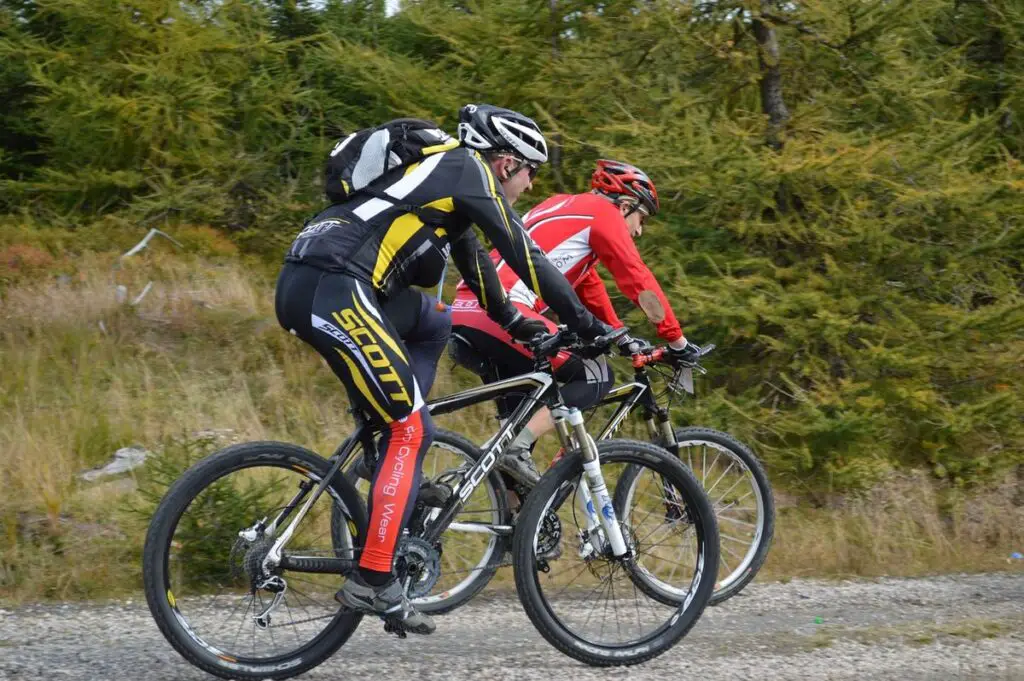
Are you looking for a mountain bike that is perfect for climbing? You should consider a hardtail mountain bike.
These bikes are specifically designed for ascending mountains, and they offer a number of benefits that can make your ride much more enjoyable.
Keep reading to learn more about the benefits of hardtail mountain bikes for climbing.
What Are Hardtail Mountain Bikes Good For? (Great For Climbing)
Hardtail mountain bikes are a popular choice for riders who enjoy spending time climbing on trails.
There are several reasons why hardtails are perfect for climbing, chief among them being their lightweight and efficient design.
Hardtails are often lighter than full-suspension bikes, making them easier to maneuver on steep inclines.
Secondly, the lack of rear suspension means that hardtails provide more direct power transfer from the pedals to the wheels, helping you to maintain speed and momentum on technical climbs.
Finally, hardtails tend to have shorter wheelbases than full-suspension bikes, making them more agile and easier to maneuver around obstacles.
So if you’re looking for a bike that will help you conquer those tough climbs, a hardtail mountain bike is a great option.
Do Hardtails Help In Maintaining Your Momentum When Climbing?
Few things are more frustrating to mountain bikers than losing all their momentum when they hit a steep hill. It can feel like you’re pedaling in place, and no matter how hard you try, you just can’t seem to make any headway.
That’s where hardtails come in. Thanks to their simple design, hardtail bikes are much easier to keep moving forward when you’re going uphill.
This is because hardtails have fewer moving parts than full-suspension bikes, so there’s less energy lost in the movement.
In addition, hardtails are typically lighter than full-suspension bikes, making them easier to pedal up hills.
The lack of rear suspension means that there’s less resistance when you’re pedaling, so you can maintain your momentum for longer.
And finally, hardtails tend to have shorter chainstays, which helps keep your center of gravity low and makes it easier to keep your front wheel planted on the ground.
If you’re looking for a bike that will help you power up hills with ease, a hardtail is a great option.
What Kind Of Ride To Expect With A Hardtails Mountain Bike?
If you’re thinking about buying a mountain bike, you might be wondering whether to choose a hardtail or full-suspension model. Both have their advantages, but hardtails tend to be more stable, making them a good choice for cross-country riding.
This is because the lack of rear suspension means that the frame is less likely to bounce around when you hit bumps in the trail. Hardtails also tend to be lighter and easier to pedal, making them a good choice for uphill sections.
However, they can be less comfortable on long rides, so it’s important to know what kinds of rides you plan on riding for a majority of your rides. Try not to choose a bike based on what you think you might ride once in a while, plan for the kinds of rides you know you’ll ride 90% of the time.
What Factors Make Hardtails Easier To Repair?
Any mountain biker will tell you that there are a lot of things that can go wrong on the trail. A flat tire, a broken chain, or even a crash can quickly ruin your ride.
Hardtails are often lauded for their simplicity, and this can extend to repairs as well. Without the need to worry about rear suspension, hardtails typically require fewer tools and less time to fix. And if something does break, it’s usually easier and faster to fix.
In addition, hardtails have fewer moving parts than full-suspension bikes and the rear triangle is typically much simpler in design. As a result, hardtails are often less expensive to maintain and repair than full-suspension bikes.
Not to mention, hardtails tend to use less expensive and easier-to-find parts than full-suspension bikes. This is due in part to the fact that rear suspension systems require more maintenance than front suspension forks.
For these reasons, hardtails can be a great option for those who are looking for a durable and low-maintenance bike. Of course, no bike is completely maintenance-free, but hardtails definitely have an advantage in this area.
Hardtail Mountain Bikes Are More Affordable Overall Than Full-Suspension
When it comes to mountain biking, there are two main types of bikes to choose from: hardtails and full-suspension.
Hardtails are typically more affordable than full-suspension bikes, making them a great option for beginner riders.
Full-suspension bikes offer more advanced features and better performance on rough terrain, but they come with a higher price tag.
If you’re just starting out, a hardtail mountain bike is a great way to get started without breaking the bank. You can always upgrade to a full-suspension bike later on as you become more experienced.
Final Thoughts
Hardtail mountain bikes have many benefits when it comes to climbing. They are lightweight and easy to maneuver, which makes them great for navigating tricky terrain. Their suspension also helps absorb shock from the trail, making it easier to ride over bumpy surfaces.
If you’re looking for a bike that is perfect for conquering climbs, a hardtail mountain bike is an ideal choice. Have you tried one out yet?
